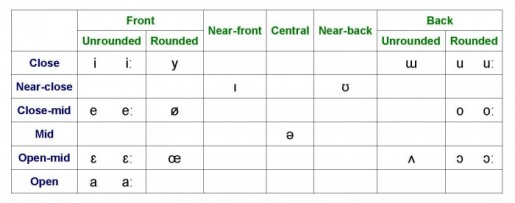1. Phonology
1.1. Consonants
1.3. Stress
1.4. Intonation
1.2. Vowels
Laefèvæšii also has a rich inventory of vowels – it has 22 vowels.
Below is the IPA's table of vowels of Laefèvëši.
In rows where some symbols appear in pairs, the symbol to the right represents a long vowel.
1.2.1. Pronunciation
1.2.1.1. Stressed and unstressed vowels
Some vowels can be stressed or unstressed, some are stressed and some vowels are just unstressed.
Stressed or unstressed vowels are: [y], [ ɯ]
Always stressed vowels are: [iː], [uː], [ɪ], [ʊ], [eː], [oː], [ə], [ɛ], [ɛː], [œ], [ʌ], [ɔ], [ɔː], [aː]
Always unstressed vowels are: [i], [u], [e], [ø], [o], [a]
1.2.1.2. Diphthongs and triphthongs
Diphthongs and triphthongs can appear in Laefèvëši, although triphthongs are not so frequent as diphthongs are.
Almost all vowels can form diphthongs and triphthongs. But not all. The rounded front vowels [y], [ø], [œ] and unrounded back vowel [ɯ] cannot form diphthongs and triphthongs, they always stand alone.
Diphthongs and triphthongs often have one vowel stressed, it can be primary or secondary stress.
1.2.1.3. Nasalization
Nasalization only appears before a nasal consonant, but the nasalization is not very noticeable.
1.2.2. Tonal vowel
Laefèvæšii has one real tone. It is a falling-rising (low dipping) tone (˨˩˦), like 3rd tone in Mandarin Chinese: ǎ in wǎn (晚 – late).
Tone appears only at the vowel ['aː] and it's always stressed and long. The “tonal a”, as it's named, it's marked as ['ăː]. It can appear alone or in diphthongs and triphthongs. But it never appears as a final or first letter of a word.

